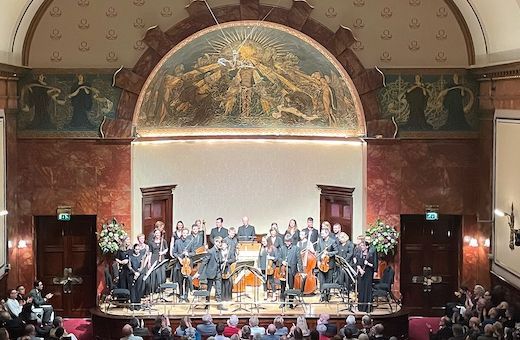How should Bach’s St Matthew Passion sound? This debate concerns voices (how many per part, all-male or mixed), speeds, articulation, modern or historic instruments, pitch, and how is a performance directed and by whom? Once this was an evangelical pursuit of an elusive notion of historical accuracy, but now the “more authentic than thou” pieties have settled into various happily (?) co-existing orthodoxies, which remarkably have shown that Bach’s Passion setting responds well to its different treatments, as do Bach lovers.

Two extremes were to be heard in London this month, as for many years. On the South Bank the very large mixed Bach Choir with six star soloists under a conductor performed the work, with a luncheon interval where the sermon would once have been. At Wigmore Hall, the Dunedin Consort gave their celebrated one-voice-to-a-part account. Four singers in each choir, plus a single ripienist. No ‘soloists’, or none who was not also a member of Choirs 1 or 2. Two orchestras, each of nine players, plus organist. More Leipzig 1736 than Edwardian London.
One element not much discussed is the acoustic space that best serves this music. Bach might have been surprised to hear it done outside a church and the liturgy, let alone in a big concert hall or a smallish recital room. But Edinburgh’s Dunedin Consort, expert ensemble in Baroque repertoire, often favours Wigmore Hall when venturing south. Even their austere approach requires 28 musicians on stage. When the platform is congested, so too, in its densest textures, is the music. At times the Wigmore’s responsive acoustic muddied the counterpoint, which can be clearer with one voice for each line, but not always here. Even the soprano ripieno, when adding her important chorale to the opening chorus, was submerged at some moments. That might have depended where you were sitting – all the singers were ranged behind the instruments throughout. In the fullest passages the loudness impaired clarity and, therefore, spirituality. Later an occasional imprecision made one feel that those anachronistic folk standing at the front with a baton can be useful. Mostly though vocal and instrumental ensemble was good, whether achieved by watching Nicholas Mulroy’s direction, or the bow of the leader, or just listening to each other like good chamber musicians.
But in the solo glories of this music, which the acoustic supports ideally, all was well. These nine voices all seemed suited to their various allotted roles – no-one is a ‘mere chorister’ in this ensemble. Arias from contralto Claudia Huckle, soprano Julia Doyle, tenor Tom Kelly and especially bass William Gaunt, whose role is so crucial later in Part Two, were very accomplished. The role of Jesus was taken by Stephan Loges, no less, who was equally authoritative in all the kinds of music he is given to sing, whether as a divine, or later mortal, being. The historic instruments all sounded splendid, and were splendidly played. Matthew Truscott’s solo violin in “Erbarme dich” was hardly less eloquent than Huckle's contralto.
Mulroy, probably now the leading Evangelist of his generation, was outstanding. Vocally he still has the pure and affecting sound of his 2007 recording with the Dunedin Consort. But the interpretation has matured, with a freely expressive fervour in his narration, his singing both rapt and rapturous. His reluctant solo bow was met with a prolonged roar.


